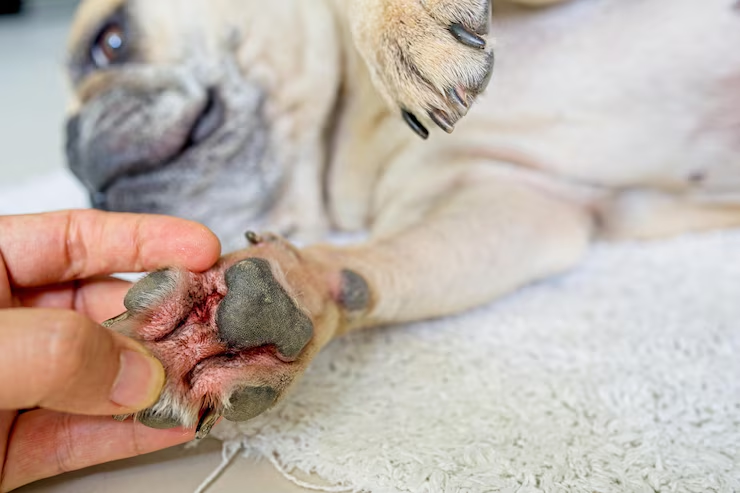Fungal skin infections in dogs are common and can cause discomfort and irritation if left untreated. Knowing how to identify and treat these infections is crucial for ensuring the health and well-being of your pet. One of the treatments commonly used for bacterial and some fungal infections is Cephalexin for dogs, an antibiotic that can also help manage infections resulting from secondary bacterial complications.
1. Types of Fungal Skin Infections in Dogs
Common types of fungal skin infections in dogs include ringworm, caused by dermatophytes, and yeast infections, often linked to Malassezia overgrowth. Ringworm presents as circular, hairless lesions, while yeast infections cause redness, itching, and a greasy appearance. Other types include sporadic infections like blastomycosis and histoplasmosis, which are less common.
Fungal infections in dogs can be caused by different types of fungi, leading to varying symptoms. Common fungal infections include:
Do you want to visit Haridwar? travel agents in Haridwar is the right place to plan your tour. You can book your tour from here.
- Ringworm: Despite the name, this is a fungal infection, not a worm. It typically presents as circular patches of hair loss and scaly skin.
- Yeast infections: These often occur in warm, moist areas of the body, like the ears or skin folds, causing itching, redness, and odor.
- Blastomycosis: A serious fungal infection that affects not only the skin but also the respiratory system, it can cause lesions on the skin and in the lungs.
2. Symptoms of Fungal Skin Infections in Dogs
Symptoms of fungal skin infections in dogs include itching, redness, and inflammation of the skin. Affected areas may develop flaky or scaly patches, hair loss, and sores. Yeast infections can cause a foul odor and greasy skin. Dogs may also exhibit excessive licking or scratching in response to discomfort. Recognizing the symptoms of fungal infections is key to ensuring your dog receives proper treatment. Common signs include:
- Itching and scratching
- Red, inflamed skin
- Hair loss in patches
- Scaly or crusty skin
- Odor from the infected area
- Open sores or lesions
If your dog shows any of these symptoms, especially in combination with behavioral changes, it’s essential to consult a vet for a definitive diagnosis.
3. How Cephalexin Helps with Fungal Infections
Cephalexin for dogs is a broad-spectrum antibiotic typically prescribed for bacterial infections. While it doesn’t directly target fungi, it’s effective in treating secondary bacterial infections that often accompany fungal infections. For example, dogs suffering from severe itching may develop skin abrasions, which can become infected with bacteria. Cephalexin helps in controlling these secondary infections, improving overall treatment outcomes. Cephalexin is not effective for fungal infections, as it is an antibiotic specifically designed to treat bacterial infections. It targets bacteria like Staphylococcus but does not work against fungi. Fungal infections require antifungal medications, such as ketoconazole or fluconazole, to eliminate the fungi and address the infection. For more details visit here Medzsupplier.
Do you want to visit char dham? char dham tour operator is the right place to plan you Char Dham tour. You can book you tour from here.
4. Topical Treatments for Fungal Infections
Topical treatments for fungal infections include antifungal creams, ointments, and powders like clotrimazole, miconazole, and terbinafine. These medications are applied directly to the affected area, targeting the fungi and alleviating symptoms. Regular application as directed is essential for effective treatment, often lasting several weeks to ensure complete fungal elimination.
In addition to antibiotics like Cephalexin, topical treatments are often the first line of defense against fungal infections. These treatments include:
- Antifungal creams or ointments: Applied directly to the infected area, these help to kill the fungi and prevent further spread.
- Medicated shampoos: Antifungal shampoos can help in treating yeast infections or widespread fungal infections, particularly in dogs with thick fur.
5. Oral Antifungal Medications
In more severe cases, oral antifungal medications may be necessary. These are prescribed by a vet and target the fungus internally. Commonly used medications include ketoconazole and itraconazole. Combining these with Cephalexin for dogs ensures that both the fungal and any bacterial infections are managed effectively. Oral antifungal medications, such as fluconazole, ketoconazole, and itraconazole, are used to treat systemic or persistent fungal infections. They work by targeting and disrupting fungal cell membranes, stopping fungal growth. These medications are prescribed for conditions like ringworm, yeast infections, and fungal nail infections, often requiring several weeks of treatment.
6. Home Remedies for Mild Fungal Infections
Home remedies for mild fungal infections include applying diluted apple cider vinegar, coconut oil, or tea tree oil, known for their antifungal properties. Keeping the affected area clean and dry is essential to prevent fungal growth. For minor cases like athlete’s foot or ringworm, these remedies may offer relief. For mild fungal infections, home remedies can sometimes provide relief. Some options include:
- Apple cider vinegar: Diluted with water and applied to the infected area, this natural remedy has antifungal properties.
- Coconut oil: Known for its soothing and antifungal effects, applying coconut oil can reduce itching and promote healing.
- Aloe vera: This natural remedy soothes irritated skin and may help in reducing inflammation caused by fungal infections.
7. Preventing Fungal Infections in Dogs
Preventing fungal infections in dogs involves maintaining proper hygiene and a clean environment. Regular grooming, bathing, and keeping the dog’s living area dry reduce moisture buildup. Ensure a balanced diet to support the immune system, avoid contact with infected animals, and promptly address any skin issues to minimize infection risk.
Preventing fungal infections requires regular grooming and maintaining a clean living environment. Here are some prevention tips:
Do you want to visit Indiar? tour operator in India is the right place to plan your tour. You can book your tour from here.
- Regular bathing: Keeping your dog clean and dry is essential, particularly after swimming or exposure to moist environments.
- Healthy diet: A balanced diet can help boost your dog’s immune system, making it less susceptible to infections.
- Frequent vet check-ups: Regular visits to the vet can catch fungal infections early, before they become severe.
8. When to See a Vet
If home remedies and topical treatments don’t seem to help, or if your dog’s condition worsens, it’s important to see a veterinarian. Persistent infections may require a combination of treatments, including Cephalexin for dogs, antifungal medications, and other therapeutic options. You should see a vet if your dog shows persistent symptoms such as excessive itching, redness, swelling, or lesions that don’t improve. Other warning signs include unusual behavior, loss of appetite, vomiting, diarrhea, or difficulty breathing. Prompt veterinary care is essential for diagnosing and treating potential health issues effectively.
Conclusion
Fungal skin infections in dogs are treatable, but prompt attention is necessary to prevent complications. Whether using topical treatments, home remedies, or antibiotics like Cephalexin for dogs to manage secondary infections, a comprehensive approach ensures your dog’s health and comfort.


